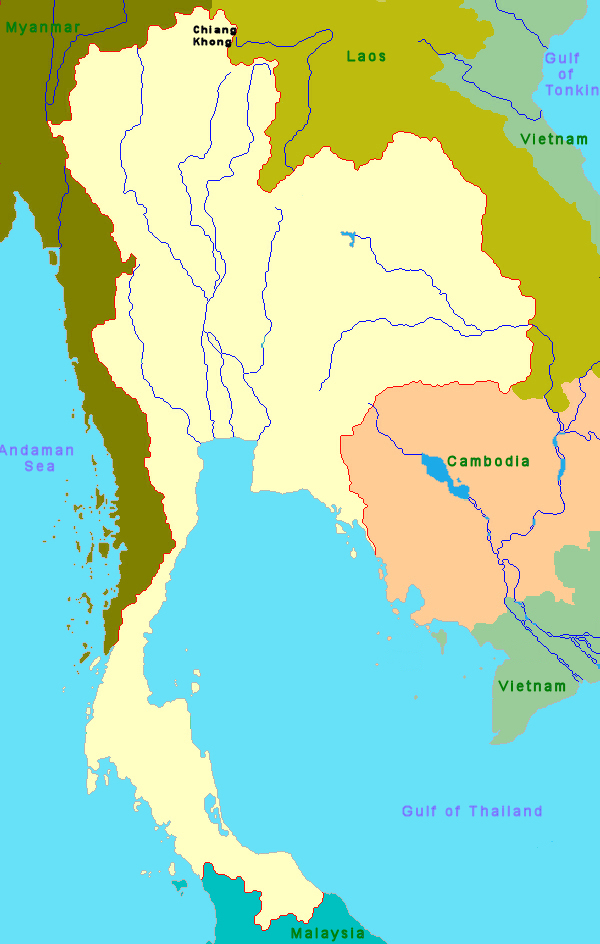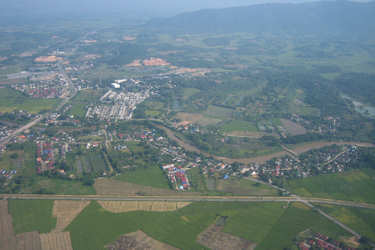Thailand

Historie
There is evidence of continued human habitation in present-day Thailand dated to 20.000 years before present.
Earliest evidence of rice growing was dated 2.000 BC. Bronze appeared during 1/250–1/000 BC. The site of Ban Chiang in Northeast Thailand
currently ranks as the earliest known center of copper and bronze production in Southeast Asia. Iron appeared around 500 BC.
Kingdom of Funan was the first and most powerful South East Asian kingdom at the time (2nd century BC).
Mon people established principalities of Dvaravati and kingdom of Hariphunchai in the 6th century AD. Khmer people established
Khmer Empire centered in Angkor in the 9th century.
Tambralinga, a Malay state controlling trade through Malacca Strait, rose in the 10th century.
The Thai are part of a larger ethno-linguistic group known as the Tai, a group which includes the Lao, the people of the Shan region
of northeastern Burma, the Zhuang people of Guangxi Province in China and the Thö people and Nùng people of northern Vietnam.
Migrations from southern China to Southeast Asia took place primarily during the first millennium AD, most likely via northern Laos.
During the first millennium AD the Tai peoples were loosely organised in small entities known as muang. They were heavily influenced by the
more advanced cultures around them: the Khmer to the east, and the Hindu cultures of India to the west.
Most of the Tai were converted to a form of Hinduism, traces of which can still be seen in Thai religious practice today.
Between the 6th and 9th centuries AD, Buddhism was introduced into the Tai-speaking lands, probably via Burma, and became the dominant religion.
Around 1240s, Si Inthrathit, a local Tai ruler, rallied the people to rebel against the Khmer. He later crowned himself the first king of
Sukhothai Kingdom (1238–1438). Sukhothai expanded furthest during the reign of Ram Khamhaeng (1279–98).
However, it was mostly a network of local lords who swore fealty to Sukhothai, not directly controlled by it.
To the north, Mangrai who descended from a local ruler lineage of Ngoenyang, founded the kingdom of Lan Na in 1292, centered in Chiang
Mai. He unified the surrounding area and his dynasty would rule the kingdom continuously for the next two centuries. He also created a network of
state through political alliance to the east and north of Mekong.
The Kingdom of Lavo was a political entity (mandala) on the left bank of the Chao Phraya River from the end of Dvaravati civilization, around
the 7th century, until 1388. The original center of Lavo civilization was Lavo (modern Lopburi), but the capital shifted southward to Ayutthaya
around the 11th century, whereupon the state became the Ayutthaya Kingdom (1350–1767) according to recent historical analysis.
Before the end of the 15th century, Ayutthaya invaded Khmer Empire trice and sacked its capital Angkor. Ayutthaya then became a regional great
power in place of Khmer Empire. Constant interference of Sukhothai effectively made it a vassal state of Ayutthaya and was finally incorporated
into the kingdom.
European contact and trade started in the early 16th century, with the envoy of Portuguese duke Afonso de Albuquerque in 1511, followed by the
French, Dutch, and English.
In 1767, after dominating southeast Asia for almost 400 years, the Ayutthaya Kingdom was brought down by invading Burmese armies.
Despite its complete defeat and occupation by Burma, Siam made a rapid recovery. The resistance to Burmese rule was led by a noble of Chinese descent,
Taksin, a capable military leader. Initially based at Chanthaburi in the south-east, within a year he had defeated the Burmese occupation
army and re-established a Siamese state with its capital at Thonburi on the west bank of the Chao Phraya. In 1768 he was crowned as King Taksin
(now officially known as Taksin the Great). He rapidly re-united the central Thai heartlands under his rule, and in 1769 he also occupied
western Cambodia.
He then marched south and re-established Siamese rule over the Malay Peninsula as far south as Penang and Terengganu. Having secured his base in
Siam, Taksin attacked the Burmese in the north in 1774 and captured Chiang Mai in 1776, permanently uniting Siam and Lan Na.
In his final years there was a coup which was caused by his supposedly "insanity," and eventually Taksin and his sons were executed by longtime
companion General Chao Phraya Chakri (future Rama I). He was the first king of the ruling Chakri Dynasty and founder of the Rattanakosin
Kingdom (1782–1932).
In the reign of Mongkut (1851–68), who recognized the threat of Western powers, the court contacted the British government directly to defuse
the tension. A British mission led by Sir John Bowring, Governor of Hong Kong, led to the conclusion of Bowring Treaty, first of many
unequal treaties with Western countries. It, however, brought economic development in Bangkok and international trade.
In 1893 French authorities in Indochina used a minor border dispute to provoke a crisis. French gunboats appeared at Bangkok and demanded the cession
of Lao territories east of the Mekong. King Rama V appealed to the British, but the British minister told the king to settle on whatever terms
he could get. The king had no choice but to comply. Britain's only gesture was an agreement with France guaranteeing the integrity of the rest of
Siam. In exchange, Siam had to give up its claim to the Tai-speaking Shan region of northeastern Burma to the British.
The French, however, continued to pressure Siam, and in 1906–1907 they manufactured another crisis. This time Siam had to concede French control
of territory on the west bank of the Mekong opposite Luang Prabang and around Champasak in southern Laos, as well as western Cambodia.
The bloodless revolution took place in 1932, carried out by the Khana Ratsadon group of military and civilian officials resulted in a transition
of power, when Prajadhipok (also known Rama VII) was forced to grant the people of Siam their first constitution, thereby ending centuries
of absolute monarchy.
In 1954 Thailand signed Southeast Asia Treaty Organization (SEATO) to become an active ally of the United States. SEATO was intended to be a
Southeast Asian version of the North Atlantic Treaty Organization (NATO), in which the military forces of each member would be coordinated to
provide for the collective defense of the member states.
Unlike the NATO alliance, SEATO had no joint commands with standing forces. In addition, SEATO's response protocol in the event of communism presenting
a "common danger" to the member nations was vague and ineffective, though membership in the SEATO alliance did provide a rationale for a large-scale
U.S. military intervention in the region during the Vietnam War (1955–1975)
Constant unrest and instability, as well as fear of communist takeover after Fall of Saigon (30 April 1975), made some ultra-right groups
brand increasingly leftist students as communists. This culminated in Thammasat University Massacre in October 1976.
A coup d'état on that very day brought Thailand a new ultra-right government, which oppressed many media outlets, officials, and intellectuals, and
fueled the Communist insurgency further. Another coup in the following year installed a more moderate government, which offered amnesty to communist
fighters in 1978. The Party abandoned the insurgency by 1983. Thailand had its first elected Prime Minister in 1988.
The populist Thai Rak Thai party, led by prime minister Thaksin Shinawatra, governed from 2001 until 2006. His policies were successful
in reducing rural poverty and initiated universal healthcare in the country.
Massive protests against Thaksin led by the People's Alliance for Democracy (PAD) started in his second term of premiership and fulled with
alleged corruption changes, ended with a coup d'état in 2006.
After the general election of 2011, the populist Pheu Thai Party won a majority and Yingluck Shinawatra, Thaksin's younger sister, became
Prime Minister. The People's Democratic Reform Committee organized an anti-Shinawatra protest after the ruling party tabled amnesty bill
which would benefit Thaksin.
Yingluck dissolved the parliament and a general election was set up. However, it was invalidated later by the Constitution Court. The crisis ended
with another coup d'état in 2014, the second coup in a decade.
The National Council for Peace and Order, a military junta led by General Prayut Chan-o-cha, has led the country since.
I visited Thailand in december 2007
These are the places I have seen on that trip
Chiang Khong
Please let me know when you're having questions.
i would be pleased to help you.
Things to do and other tips
